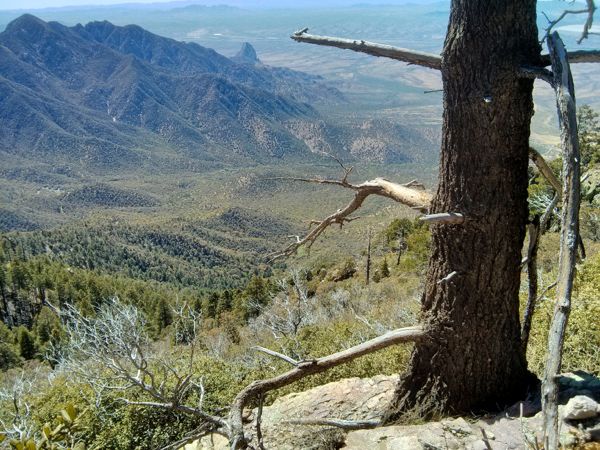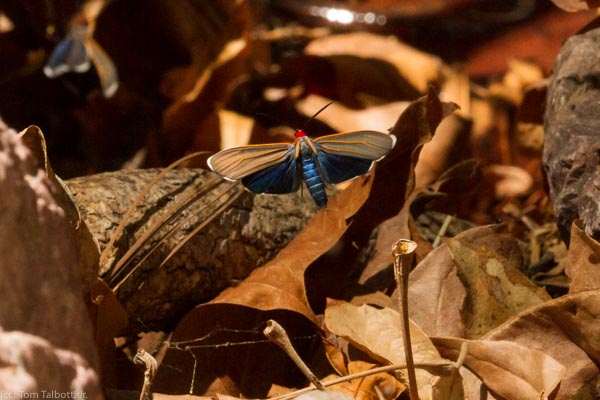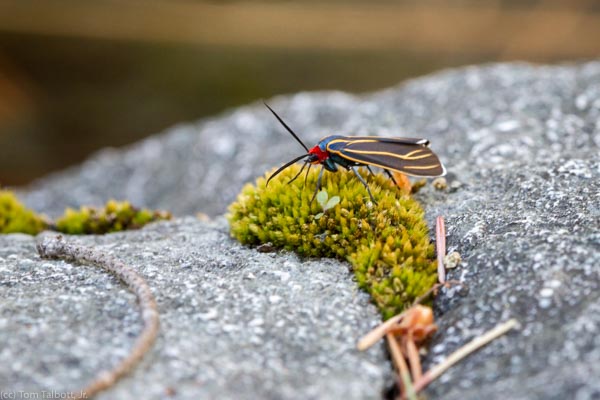Day 229: Mountain time
 May 17, 2017
May 17, 2017 Imagine this.
You start by driving away from the city, into the desert. A few flat, hot hours go by. You are surrounded mostly by cactus. The only signs of water are the dry washes carved into the ground by summer storms.
Eventually, you begin to gain elevation. Cactus dwindle, replaced by grasses. There is less bare ground between plants. As you continue to climb, you begin to see more trees—short, twisted oaks and junipers that are still more shrubs than trees. Farther up, these get taller, now providing a little filtered shade. Yuuca’s outnumber the cactus. There is dry bunchgrass everywhere.
When you run out of road, you park the car and start walking. The steep trail ascends rapidly up the side of a vast, craggy mountain. You begin to see views of the valley and the city you started from in the distance. The oaks are taller, especially in the ravines, but there is still no visible water. Here there are manzanitas and little forest flowers—heuchera in the shade and paintbrush where it is sunnier. The trail is steep and dusty. The sun feels like a hot bulb suspended directly overhead. Every scrap of shade from the scattered trees on the ridges is a relief.

After over an hour of climbing you are high on the mountain. The valley below spreads away into distant haze. There are real trees here—mostly pines. The trail levels off close to the rocky ramparts of the mountain peak. You traverse a ridge then drop down into a fold in the mountainside.
As you enter the bottom of the ravine the world changes completely. For the first time in all these hot miles, a little stream gurgles up out of the ground. The air is quiet and cool. Long-needled pines and a Douglas fir tower an impossible height above you. Huge, white-trunked sycamores glow in the lighted shadows. Light-green ferns grow thick on the duffy ground. Moss covers the rocks. Even a little purple violet blooms in the stream. Sunlight slips through the leaves in sparkling patches on the water.
But most magical of all, the air above the stream is alive with wings. Hundreds of butterfly-like moths are rising up from the short stretch of flowing water in a loose flittering cloud of color and light. Each moth’s hind-wings are shiny metallic blue, their thick bodies are a soft powder-blue, and their round heads glow vivid red. At rest, with their orange-veined wings folded over their backs, they blend into the needles, but they are not often at rest, but are in constant twinkling, sparkling flight.

As I watch this swirl of colored wings, I feel like there should be music. The creek purls and trickles and crescents down over the wet rocks. The sun shines silently. I ask humble forgiveness for all the times I scoffed at fantasy movies in which the forest air was filled with fluttering, gossamer drifting stuff, as being “unreal.” This, too, feels unreal, but it is right here, moths rising and falling, tumbling and circling, landing on mud, opening and closing their wings, taking to the air again. This is also reality: as real as the long, hot walk to get here; as real as the fast, hot city in the distance.
And like most of reality it is fleeting. By the time we leave the stream late that afternoon, many of the moths have either dispersed or are stuck and drowning in deeper pools, littering the shore of the creek. Over the next weeks we see them many times in ones and twos, but never again in such numbers, even back at the same spring.
From what I can tell, these are Veined Ctenucha or Ctenucha venosa, a moth of the southwest that is active by day and whose larva feed on grasses. Why was there such a swarm of them? There must be some good reason—there always is—but I don’t know what it was. All I know is that it was memorable, as was all of Mt. Wrightson, its richness rising island-like out of the sea of desert.

One thing this trip is about, is time; and having time allows a different perspective. With this kind of time, watching a flight of moths might be the most important thing I do all day. And with time I tend toward a certain kind of watching—not observing so much for the sake of knowledge or understanding, but simply for the delight of it. The kind of watching that is a kind of homage or a prayer to what is, in all its magnificent detailed variety.
-----------
We spent a week and a half at Madera Canyon on Mt. Wrightson in the Santa Rita Mountains south of Tucson, walking and working and writing and being amazed at the incredible variety of plants, birds, lizards, and insects who make their home on this “sky island.”
 Creatures
Creatures